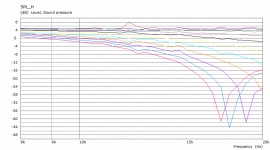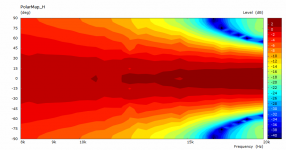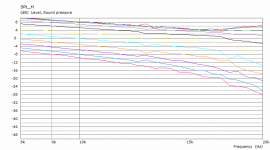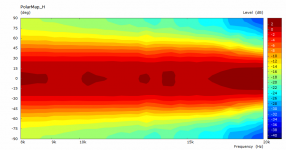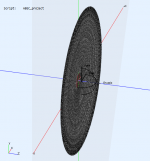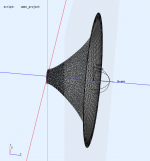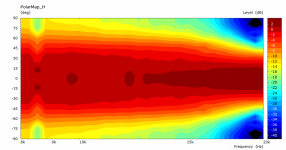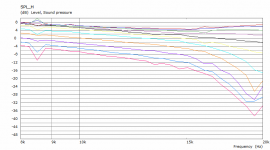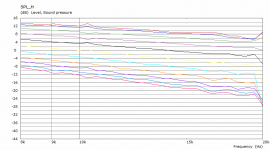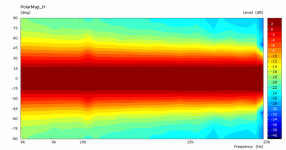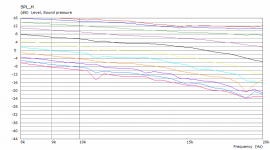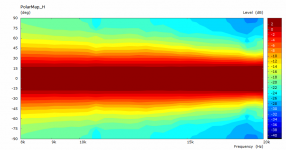Oh no, we are back at this againTry measuring a bare compression driver, they show significant pattern control above 10KHz. How can a waveguide without a diffraction slot make this wider? I'm assuming your "waveguide done properly" does not have a diffraction slot.
OK, I just quickly simulated the following two cases:
a) 175deg OS waveguide, i.e. almost a flat baffle, which is really the limiting case for an OS waveguide as coverage angle approaches 180deg;
b) 90deg OS wavaguide.
The pictures will follow...
Since the flat baffle is the limiting case for an OS waveguide as the coverage widens (up to 180deg), there must be a continuum.
Any comments or suggestions?
- Does anyone know how to thicken the plot lines in VACS?
Any comments or suggestions?
- Does anyone know how to thicken the plot lines in VACS?
Attachments
Last edited:
I can but it makes a huge difference in BEM running times. I try to limit the mesh resolution as possible to speed things up. There's still a lot to look at and improve between 1k - 10k. IMO, there's too many unknowns above 10 kHz that it makes little sense to try to simulate it this way. I can try occasionally. This might be an interesting case.Seems the over 10K response is smoother without the big dip in the M2 clone, could you extend the sim to go to 20K to see it better?
Yes.post 993.
the graph on the right (when 2 graphs shown), that is the non knuckles ?
Yes. The graphs are labeled "SPL_H / SPL_V / SPL_D" accordingly.what are the graphs, left to right again ? vertical, horizontal, diagonal ?
I think the pattern is obvious (and it has been said many times) - as the coverage angle is increased or the throat made larger, the lower in frequency come all the HOMs into play - the device deviates from constant directivity of a pure spherical wave. The flat baffle being a special case of the maximum coverage angle, i.e. the worst case for a given throat size.
Last edited:
Mabat
Thanks for those plots. They prove what I have said from the beginning: that a waveguide does not have the polar limitations of the source. This was predicted by the theory, shown by my measurements and now again shown by simulations. I hope this puts this incorrect belief to bed, Finally!
The waveguide does narrow as the angle is made wider, but this is not driver dependent at all. In reality driver wavefront coherence degrades at the upper frequencies and that causes reality to differ from the theory, but this is due to the inability of specific drivers to maintain a flat wavefront. It is not inherent in the design itself.
Improved phase plugs may help this situation, but little to nothing is known about the flatness of driver exit waveforms. About a decade ago I showed (B&C) how this situation could be measured in a PWT, but it was never followed through. To me, that would be the next piece of the puzzle that will need to be analyzed in order to progress the directivity control to ever higher frequencies - if that indeed is actually worth doing.
I have my doubts.
Thanks for those plots. They prove what I have said from the beginning: that a waveguide does not have the polar limitations of the source. This was predicted by the theory, shown by my measurements and now again shown by simulations. I hope this puts this incorrect belief to bed, Finally!
The waveguide does narrow as the angle is made wider, but this is not driver dependent at all. In reality driver wavefront coherence degrades at the upper frequencies and that causes reality to differ from the theory, but this is due to the inability of specific drivers to maintain a flat wavefront. It is not inherent in the design itself.
Improved phase plugs may help this situation, but little to nothing is known about the flatness of driver exit waveforms. About a decade ago I showed (B&C) how this situation could be measured in a PWT, but it was never followed through. To me, that would be the next piece of the puzzle that will need to be analyzed in order to progress the directivity control to ever higher frequencies - if that indeed is actually worth doing.
I have my doubts.
I think what may be easily misleading here is the notion of a directivity of a source by itself, without considering any boundary conditions, or thinking of a directivity pattern in an infinite baffle as something inherent to the source. Change the boundary conditions and the whole situation is different.
For me the good news is the confirmation that 1,4" drivers can be used without a problem, provided they output a high quality wavefront. Many of the modern ones seem to be quite good.
For me the good news is the confirmation that 1,4" drivers can be used without a problem, provided they output a high quality wavefront. Many of the modern ones seem to be quite good.
Last edited:
I think what may be easily misleading here is the notion of a directivity of a source by itself, without considering any boundary conditions, or thinking of a directivity pattern in an infinite baffle as something inherent to the source. Change the boundary conditions and the whole situation is different.
This is precisely the same answer that I always gave, but people just didn't buy it.
Your math understanding of this is very good. I just wish that I had your tools back-in-the-day. The first solution of the OS waveguide took me more than a year. Now its a few minutes!
Oh you must have had a great timeThe first solution of the OS waveguide took me more than a year. ...
Oh no, we are back at this...
there must be a continuum...
Any comments...
First comment is- thank you very much, this is exactly the data I have tried to find.
The continuum issue is one I raised with Earl but never came to any conclusion.
I will try to write a sensible comment after I think more about your posts.
They deserve a considered response, excellent work.
Best wishes
David
Improved phase plugs may help this situation, but little to nothing is known about the flatness of driver exit waveforms. About a decade ago I showed (B&C) how this situation could be measured in a PWT, but it was never followed through. To me, that would be the next piece of the puzzle that will need to be analyzed in order to progress the directivity control to ever higher frequencies - if that indeed is actually worth doing.
I have my doubts.
I'd really love to play around with the JBL 2409H and the 2410H but they're not easy to buy. (Not for sale at retail.)
The 2409H is in the JBL 705P and it has a 16mm throat (21,250Hz)
The 2410H is two years newer, and it has a 25mm throat (13,600Hz)

The phase plug of the 2410H extends all the way into the horn.
This makes me wonder if the latter solution worked better than the former solution.
Last edited:
- Home
- Loudspeakers
- Multi-Way
- Acoustic Horn Design – The Easy Way (Ath4)
